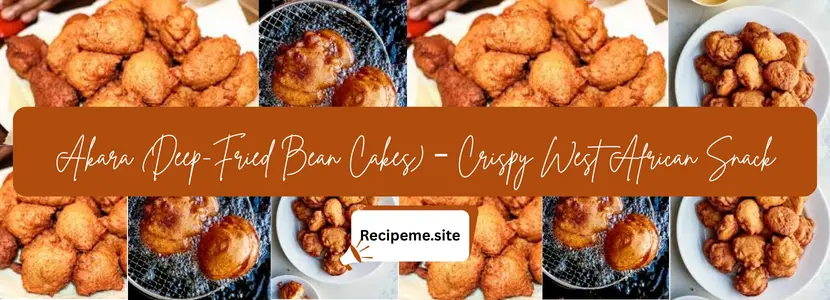
Introduction
Have you ever woken up to the irresistible aroma of something frying in hot oil, golden and crispy on the outside but fluffy and savory inside? That, my friend, is the magic of Akara (Deep-Fried Bean Cakes).
In many West African homes, akara is more than breakfast—it’s a tradition. From busy Lagos streets to cozy Ghanaian kitchens, akara has been enjoyed for centuries. But why is this humble bean cake so beloved? Is it the crunch, the comfort it brings, or the memories of family mornings it evokes? Let’s dive into the world of akara and find out.
History of Akara
Akara has deep roots in West African culinary history. Originating from the Yoruba people of Nigeria, it quickly spread across neighboring countries like Ghana, Sierra Leone, and Cameroon.
In Nigeria, akara is traditionally eaten in the mornings, often paired with pap (fermented corn porridge) or bread. During festive periods, it’s also served at community gatherings, weddings, and naming ceremonies. Interestingly, enslaved Africans carried akara recipes to the Americas, where it evolved into dishes like Brazilian acarajé.
Did You Know? Akara was once used by Yoruba women as a ceremonial food, sold at markets to raise funds for community projects. It wasn’t just food; it was empowerment.
Essential Ingredients for Akara
The beauty of akara lies in its simplicity. You only need a few key ingredients, yet the flavors are bold and satisfying.
-
Black-eyed peas (beans) – the foundation of akara.
-
Onions – for depth of flavor.
-
Scotch bonnet or chili peppers – for a spicy kick.
-
Salt and seasoning cubes – to enhance taste.
-
Vegetable or palm oil – for deep frying.
-
Optional spices – garlic, ginger, or paprika for extra flavor.
Pro Tip: The secret to fluffy akara is aeration—whip the bean paste until it’s light before frying.
Variations of Akara
Every region has given akara its own twist. Here are a few:
-
Nigerian Akara: Classic style, spiced and paired with pap or bread.
-
Ghanaian Koose: A similar dish often eaten with millet porridge (Hausa koko).
-
Brazilian Acarajé: A version stuffed with shrimp and vatapá (spiced paste).
-
Vegetable Akara: Blended with spinach, carrots, or bell peppers.
-
Mini Snack Akara: Bite-sized balls for parties and events.
Preparation: Step-by-Step Guide
Here’s a tried-and-tested method for making crispy, golden akara at home.
Ingredients (serves 4):
-
2 cups black-eyed peas
-
1 medium onion
-
2 fresh chili peppers (or scotch bonnet)
-
1 tsp salt
-
1 bouillon cube (optional)
-
2 cups vegetable oil (for frying)
Instructions:
-
Soak and Peel the Beans
-
Soak beans in water for 30 minutes, then rub between your palms to remove the skins. Rinse until skins are gone.
-
-
Blend the Batter
-
Combine beans, onions, and peppers in a blender. Add very little water and blend into a thick paste.
-
-
Whip the Mixture
-
Pour into a bowl and beat with a whisk or wooden spoon until light and airy. This ensures fluffiness.
-
-
Heat the Oil
-
In a deep pan, heat oil until hot (test with a drop of batter—it should sizzle immediately).
-
-
Fry the Akara
-
Scoop batter with a spoon and drop into hot oil. Fry until golden brown on all sides, turning as needed.
-
-
Drain and Serve
-
Remove akara with a slotted spoon and drain on paper towels. Serve hot with pap, bread, or sauce.
-
Did You Know? Some street vendors fry akara in palm oil, giving it a deeper flavor and an inviting reddish hue.
Cultural Significance of Akara
Akara is more than just food—it’s part of West African identity.
-
In Nigeria, akara is a symbol of togetherness, often prepared in large quantities for family gatherings.
-
In Ghana, koose is a comfort food that warms up chilly mornings when paired with porridge.
-
Across Africa, akara represents resilience and tradition, showing how a simple bean has been transformed into a dish loved for centuries.
Serving Suggestions
Akara is versatile and can be enjoyed in many ways:
-
With pap (ogi/akamu) for a classic Nigerian breakfast.
-
Tucked inside agege bread for a delicious akara sandwich.
-
Alongside custard or porridge in Ghana.
-
As a snack or appetizer at events.
-
With pepper sauce or shito for extra spice.
Types of Akara
While the basic recipe is common, variations exist based on size, texture, and accompaniments:
-
Round Ball Akara – the most common style.
-
Flat Fritters – slightly flattened for crispier edges.
-
Stuffed Akara – filled with shrimp, fish, or vegetables.
-
Palm Oil Akara – fried in red palm oil for a smoky flavor.
Tips for Perfect Akara
-
Peel beans thoroughly for a smooth paste.
-
Don’t add too much water when blending.
-
Whip batter well to incorporate air.
-
Fry in batches—overcrowding lowers oil temperature.
-
Serve hot—akara is best enjoyed fresh from the pan.
Other Valuable Insights
-
Nutritional Value: Akara is rich in protein from beans, making it an affordable source of nutrition.
-
Hidden Fact: In Yoruba culture, akara is often cooked during funeral ceremonies to celebrate the life of the departed.
-
Expert Insight: Adding ground crayfish or shrimp powder to the batter elevates flavor.
Personal Experience: My Journey with Akara
The first time I tasted akara was on a chilly Saturday morning in Lagos. A vendor was frying by the roadside, and the aroma of beans and onions in hot oil was too tempting to resist. I bought a paper-wrapped portion, still steaming, and paired it with freshly baked bread. The crunch, the warmth, the comfort—it wasn’t just food; it was nostalgia in a bite.
Even today, whenever I make akara at home, I’m reminded of that morning. For me, akara isn’t just breakfast—it’s a memory, a connection to culture, and a reminder that the simplest foods often carry the richest stories.
Conclusion
Akara (Deep-Fried Bean Cakes) is more than a crispy snack—it’s a cultural icon. With its rich history, simple ingredients, and comforting taste, akara continues to bring people together across generations and continents. Whether you’re enjoying it with pap in Nigeria, koko in Ghana, or even acarajé in Brazil, one thing remains the same: akara is food that speaks to the soul.
Frequently Asked Questions
1. What is akara made of?
Akara is made from peeled black-eyed peas blended with onions, peppers, and spices, then deep-fried until golden.
2. Is akara healthy?
Yes, akara is high in protein and fiber, but since it’s fried, moderation is key.
3. Can I make akara without peeling the beans?
For authentic texture, the beans should be peeled. Leaving skins on results in a coarse batter.
4. What oil is best for frying akara?
Vegetable oil is commonly used, but palm oil adds a unique flavor.
5. Can akara be baked instead of fried?
Yes, but the texture won’t be as crispy. Baking is a healthier option.
6. What’s the difference between akara and koose?
They are essentially the same dish, but in Ghana it’s called koose and often served with millet porridge.
